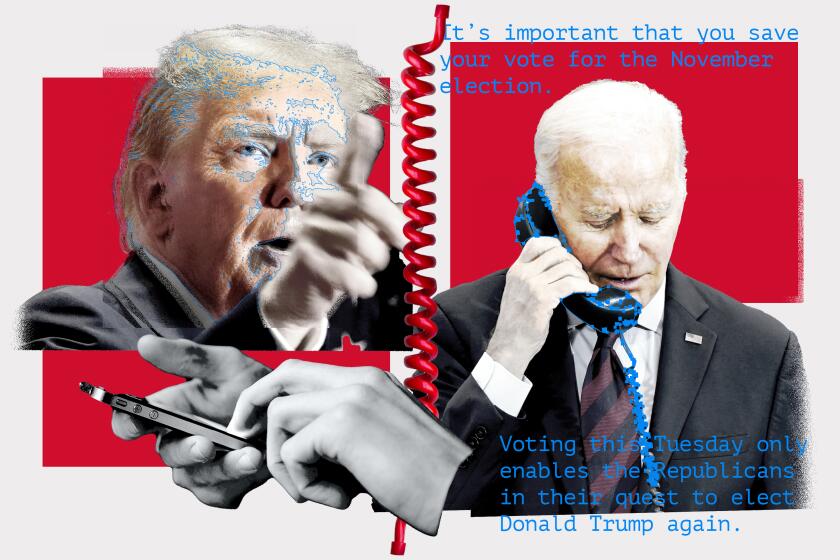It takes a will to get a Wii
Wii’re all sold out.
Legions of shoppers are getting the message nearly everywhere they look for Nintendo Co.’s video game console.
Even though it ramped up production capacity twice this year, Nintendo isn’t meeting demand for the Wii, which has been on the market for more than a year and is, somehow, this season’s hottest hard-to-find gift.
Nintendo executives said the Japanese company had thought its production schedule -- about 1.8 million consoles a month -- would be sufficient.
But because components have to be ordered five months in advance, they said, Nintendo can’t crank up output at its factories in China to meet the holiday shopper onslaught.
So lines of Wii wannabes snake for blocks around stores. By 5 a.m., hundreds of hopefuls are outside Nintendo’s flagship outlet in New York’s Rockefeller Center. In Southern California, some stores hand out tickets to Wii-seekers who queue up, letting them know how many are available. In recent days at Best Buy stores in Simi Valley and Thousand Oaks, throngs have been turned away, empty-handed and unhappy.
Some people accuse Nintendo of playing hard to get.
“I suspect that Nintendo is doing this intentionally,” said Dennis Leon, a veterinarian from Long Island, N.Y., who purchased a Wii when a Toys “R” Us clerk tipped him off to a new shipment. “I wonder if they’re doing this so that it gets this aura of the gaming system that’s not easy to get.”
That’s not the case, said George Harrison, the company’s head of marketing in North America and someone who knows how serious the situation is: He was approached on a recent flight from New York to Seattle by five strangers asking if he could help them score Wiis.
Nintendo increased capacity in the spring and again in the summer, he said. In January, Nintendo shipped 1 million consoles a month, he said, and now it ships about 1.8 million a month, divided about equally among North America, Europe and Asia.
“We thought we were being aggressive,” Harrison said. “But, clearly, demand continues to outstrip supply.”
About half of the video game industry’s annual sales occur during the last three months of the year. Harrison said Nintendo wanted to ride the boom-and-bust nature of the business by finding a steady output rate that could satisfy customers without adding too much capacity, which can pump up costs when demand slackens and equipment goes idle.
“Normally we’d build up inventory over the summer when demand is slower,” he said. “Instead, we ended up selling everything we could make this summer. As a result, we went into the holidays without any additional inventory.”
The shortage is unprecedented for a console more than a year old, said Billy Pidgeon, an analyst with research firm IDC. “With the Wii, there was never a lull in demand.”
He said the Wii dearth has had a positive effect on sales of other consoles, including Sony Corp.’s PlayStation 3 and Microsoft Corp.’s Xbox 360, but that it would be limited. The Wii appeals to casual gamers and “most people who set out to buy the Wii aren’t going to want the other consoles as much,” he said. “They’re not the same product.”
Another reason for the Wii’s popularity is its price: At $249, it’s $30 to $250 cheaper than various versions of the Xbox 360 and PlayStation 3. Games for the Wii also tend to be less expensive, by about $10 to $20 a title.
And the Wii is popular with people who don’t normally consider themselves gamers, parents and grandparents included. For them, word of mouth drives interest -- which is not the case for hard-core gamers who tend to buy early.
Whatever the reason, the scarcity of the Wii is working to Nintendo’s advantage.
“Managed properly, a product shortage can be a bonanza in increasing total long-term sales,” said Peter Sealey, an adjunct marketing professor at the Drucker School of Management at Claremont Graduate University. “A shortage creates an aura -- it creates a demand. There’s a herd instinct.”
That instinct is driving up prices. Resellers snag the console at the regular price, mark it up several hundred dollars and sell it online through EBay, Amazon.com or Craigslist. Retailers are selling bundles, which include the console, a few games and extra controllers, for as much as $595.
That turns off some consumers.
“Very few places were selling just the console,” said Garry Upton, a 33-year-old design analyst for an electric utility in Little Rock, Ark. “The bundles they did have would give you games you didn’t really want.”
A website dedicated to helping shoppers -- WiiAlerts.com -- has popped up, of course. A week after signing up on the website, Phil Longueuil of Roseville, Mich., got a text message on his cellphone telling him that some consoles were available on Amazon.
He dashed to his computer and snapped up one before the online merchant sold out minutes later.
“Now I can be a hero to my 8-year-old at Christmas.”
----
(BEGIN TEXT OF INFOBOX)
How to score
Visit WiiAlerts.com, which combs online retailers. You’ll get an e-mail or text message when there is Wii availability.
Buddy up to store clerks. They often know when a shipment is scheduled to arrive. Some might even call you when they have consoles in stock.
Hit out-of-the way stores. You could get lucky.
Bid on EBay or try an Amazon.com reseller or Craigslist. Caveat emptor: You’ll pay $400 to $600 for a console that costs $249 in stores. Be on the alert for scammers selling used or defective products. Insist on a dated store receipt, preferably for a unit that was purchased within the store’s allowable return period in case something goes wrong.
Wait. Demand will slacken after the gifts have been doled out, and Nintendo will continue to crank out roughly 600,000 consoles a month for North America.
--
Sources: Charlene Li, Forrester Research;
Nintendo Co.



